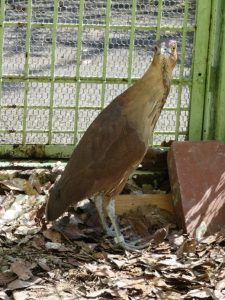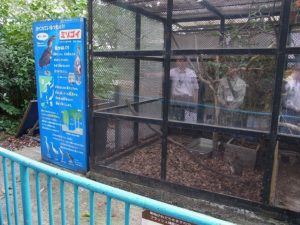Breeding initiatives for the Japanese night heron(Gorsachius goisagi)
Yokohama Greenery Foundation
Yokohama Municipal Kanazawa Zoo
Eiji Onda
Japanese night heron
The Japanese night heron (Gorsachius goisagi) (Fig. 1) is a summer bird of the family Ardeidae that inhabits forests ranging from flatlands to low mountains. With a color that resembles that of fallen leaves and the ground, the Japanese night heron performs a characteristic mimicking behavior of hiding itself by straightening its neck and pretending to be a tree branch when it feels threatened.
It is thought that the population of Japanese night herons, which breed almost exclusively in Japan from spring to summer, had continuously declined since 1960 due to the impacts of deforestation and land development of suitable nesting areas (Kawakami et al., 2003); and the species is currently designated as Vulnerable (VU) on the Red List of the Ministry of the Environment of Japan.

Fig. 1. Japanese night heron (Yokohama Kanazawa Zoo, male)
During the breeding season, the bird cries out with its “Voo, Voo” sound, seeking out an individual to pair with. Unlike other heron species, multiple individuals of this species do not gather to nest, with each pair nesting independently. Such habits have been said to make the bird difficult to discover.
The Japanese night heron feeds on small animals and is positioned at the top of the food chain, therefore, it is considered to indicate the diversity of the organisms and environment in its habitat. Given this context, in June 2016, the Ministry of the Environment announced its “Ways to proceed with the protection of the Japanese night heron”, clarifying information to the concerned parties on the Japanese night heron and responses when its habitat was confirmed, with the objective of the conservation of the Japanese night heron and its habitat.
Protection at Yokohama City Zoos
With the animal protection project in Kanazawa Prefecture as its basis, the Yokohama City Zoos (Yokohama Zoo, Nogeyama Zoo, and Kanazawa Zoo) have played an important role since 1972 as a relief facility for injured wild animals that were protected by the general public in the prefecture.
Within the scope of this project, the three zoos have protected and housed 18 Japanese night herons since 1981 (Table 1). Of those 18 protected individuals, 11 were protected in either April or October, accounting for 61% of the total. Furthermore, nine birds, i.e., half of the total, were protected within Yokohama City; and six birds, , i.e., a third of the total, were protected due to traumatic injuries such as bone fractures. Only one individual among these could be subsequently released into the wild.
Table 1. Record of protection at Yokohama City Zoos
| Zoo location of protected animal |
Sex | Protection area | Protection date (mm-dd-yyyy) |
Protection Status | Outcome |
|---|---|---|---|---|---|
|
Nogeyama Zoo |
Unknown |
Kanazawa Ward, Yokohama City |
4-25-1981 |
Left leg fracture |
Death |
|
Nogeyama Zoo |
Unknown |
Kanagawa Prefecture |
7-10-1981 |
Unknown |
Death |
|
Nogeyama Zoo |
Unknown |
Kamakura city |
10-15-1982 |
Left wing fracture |
Death |
|
Nogeyama Zoo |
Female |
Asahi Ward, Yokohama City |
11-15-1984 |
Weakness |
Death |
|
Nogeyama Zoo |
Male |
Kohoku Ward, Yokohama City |
5-16-1985 |
Fracture of the wing |
Death |
|
Nogeyama Zoo |
Male |
Konan Ward, Yokohama City |
4-3-1992 |
Fracture of both legs |
Death |
|
Nogeyama Zoo |
Unknown |
Kawasaki City |
10-21-1995 |
Chased by crows |
Released into wild |
|
Nogeyama Zoo |
Male |
Shizuoka Prefecture |
10-27-1997 |
Weakness |
Death |
|
Nogeyama Zoo |
Unknown |
Hodogaya Ward, Yokohama City |
4-27-2000 |
Bitten by cat |
Released into wild |
|
Yokohama Zoo |
Male |
Aoba Ward, Yokohama City |
10-16-2004 |
Right upper arm fracture |
Transfer |
|
Nogeyama Zoo |
Unknown |
Tsurumi Ward, Yokohama City |
4-28-2008 |
Attacked by cat |
Death |
|
Nogeyama Zoo |
Male |
Kohoku Ward, Yokohama City |
11-26-2011 |
Weakness |
In captivity |
|
Nogeyama Zoo |
Male |
Sumida Ward, Tokyo |
9-16-2012 |
Weakness |
Transfer |
|
Kanazawa Zoo |
Unknown |
Yokosuka City |
8-21-2012 |
Weakness |
Transfer |
|
Nogeyama Zoo |
Male |
Kawasaki City |
4-9-2013 |
Weakness |
Transfer |
|
Nogeyama Zoo |
Male |
Tokyo |
10-30-2013 |
Weakness |
In captivity |
|
Nogeyama Zoo |
Female |
Sakai City, Osaka Prefecture |
1-10-2014 |
Weakness |
Transfer |
|
Nogeyama Zoo |
Male |
Nishi Ward, Yokohama |
10-24-2017 |
Right leg fracture |
In captivity |
Meanwhile, the breeding of individuals that have become difficult to release into the wild has led to the accumulation of breeding records, which have been scarce when considering the Japanese night heron to date. We collected information and records that are necessary for determining the nutritional status of individuals by searching for appropriate breeding management methods such as feeding content and temperature control in winter, as well as by conducting blood tests. At Yokohama Zoo, we have practiced health management such as the review of feed content while checking blood properties. As of the end of December 2018, nine of the 16 birds raised in the three zoos are from the wild, and the individual that has been kept in captivity for the longest period of time was given protection in October 2004, with a captivity duration of over 15 years.
Furthermore, Nogeyama Zoo has created an opportunity to deepen the interest of the general public toward the Japanese night heron, for which there is little awareness, by displaying individuals that cannot be released into the wild, while providing explanations on their ecology (Fig. 2).

Fig. 2. Japanese night heron exhibit at Nogeyama Zoo
Captive breeding in zoos
In June 2015, captive breeding of the Japanese night heron was confirmed for the first time in Japan at the Yokohama City Animal Breeding Center. Zoos have been engaged in captive breeding efforts for many animal species over the past several decades, and the reason why this was the first year for the Japanese night heron goes to show how scarce the records and information on its breeding have been.
Afterwards, breeding efforts were undertaken at Miyazaki City Phoenix Zoo, with a total of 25 individuals bred in both facilities by July 2018. Therefore, the number of domestically bred birds, which was only three in 2009, increased by a factor of 10 to 30 birds by 2018 (Fig. 3). Accompanying this increase has been the need for securing breeding facilities and space. In response, breeding efforts have begun at Inokashira Park Zoo in December 2018.

Fig. 3. Changes in the number of captive Japanese night herons in domestic zoos
Initiatives have only begun
The number of Japanese night herons is declining, and it is thought that ex-situ conservation should play a large role in the conservation of the species, for which there is still little information regarding its ecology and habitat. Meanwhile, many issues still need to be overcome in order to conduct captive breeding in a stable manner. The current number of captive individuals is not enough to maintain a stable population. Furthermore, the introduction of new individuals is largely dependent on the accidental occurrence of individual birds that need to be protected and housed. Simultaneously, more efforts to further securing captive breeding techniques are essential.
Despite the presence of such issues, the number of captive zoos is scheduled to further increase in Japan in 2019. Due to the bias in the sex ratio of the currently captive individuals, a system in which each zoo independently conducts breeding efforts will not function, but it is thought that an important network is being built in terms of the accumulation of information and techniques related to the Japanese heron. Furthermore, we hope that increasing the number of captive zoos would further the understanding of the general public toward the Japanese night heron.
There are still many hurdles to overcome in order to link these initiatives to in-situ conservation, and further expansion and deepening of this network is thought to be essential to achieve the increase in numbers of the Japanese night heron, that is, the realization of a “diversified” natural environment. First, we must make the conservation efforts that we have just begun into something sustainable and long-lasting by collaborating between captive zoos.
References
Kawakami, K. and H, Higuchi (2003) Population trend estimation of three threatened bird species in Japanese rural forests: Japanese Night Heron Gorsachius goisagi, Goshawk Accipiter gentilis and Grey-faced Buzzard Butastur indicus. Journal of the Yamashina Institute for Ornithology 35:19-29.
Ministry of the Environment of Japan (2016) Ways to Proceed with the Protection of the Japanese Night Heron
Kawana, K. (2012) The Japanese Night Heron: Its Ecology and Habits, ISBN: 978-4990645601.
Matsumoto, R. (2005) Rescue and breeding process of Japanese night heron (Zoo Research Bulletin Vol.7)
Sumida, A. (2006) Breeding of Japanese night heron (Zoo Research Bulletin Vol. 8).

